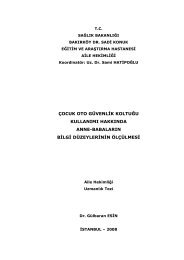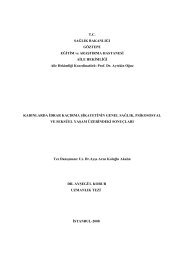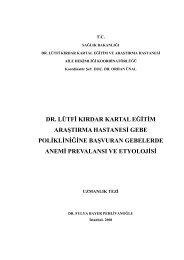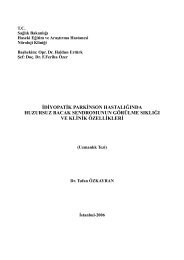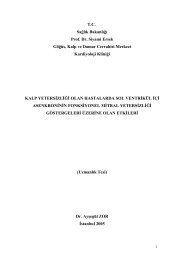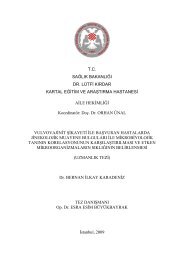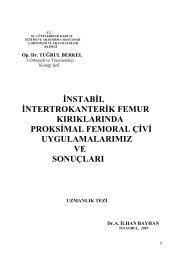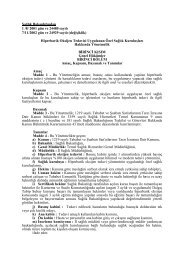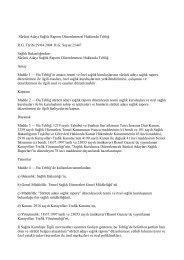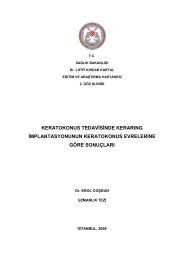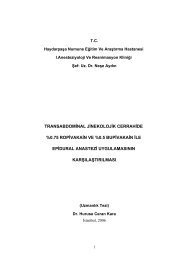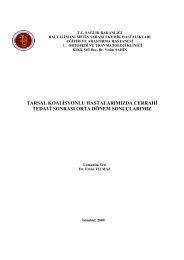TC SAÄLIK BAKANLIÄI KARTAL DR. LÃTFÄ KIRDAR EÄÄ TÄ M VE ...
TC SAÄLIK BAKANLIÄI KARTAL DR. LÃTFÄ KIRDAR EÄÄ TÄ M VE ...
TC SAÄLIK BAKANLIÄI KARTAL DR. LÃTFÄ KIRDAR EÄÄ TÄ M VE ...
You also want an ePaper? Increase the reach of your titles
YUMPU automatically turns print PDFs into web optimized ePapers that Google loves.
SUMMARY<br />
Iron deficiency is the most frequent anemia reason in the world. As well as iron<br />
deficiency is seen at all age groups, it is seen the most frequent at the nursing infants and<br />
pregnant. Effects of iron deficiency at pregnancy to fetus and/or nursing infant are still a<br />
matter for discussion. According to some researches, it is thought that iron deficiency at<br />
pregnant affects iron level of fetus and infant, increases preterm delivery revalence, causes<br />
growth and development deficiency in the fetal and long term. At some researches, it is<br />
declared that iron level of mother does not affect baby and iron depot of baby is sufficient for<br />
the first six months.<br />
350 phenomenon of term pregnant in labour who applied to Dr. Lütfi Kırdar Kartal<br />
Education and Research Hospital between years of 2008 and 2009 are included to the study.<br />
Weight and size tracing percentile tables from newborn tracing files were evaluated.<br />
(Information belonging to the child; gestation age: over 37 weeks, newborn weight: below<br />
2500 gr. (SGA), 2500 gr. and over (Normal) delivery weight, newborn size: below 50 cm., 50<br />
cm. and over, 1 and 5 min. APGAR score: below 8, over 8).<br />
Information belonging to the mother; age, gestational week and delivery method,<br />
hemoglobin, hematocrit level, whether to be received an iron treatment regularly or not, is<br />
gathered from pregnancy tracing form. Pregnant who is smoking, having diabetes, having<br />
hypertension, having a history of infection and having anemia before pregnancy other than<br />
iron deficiency anemia is not included to the study. Gestation age was evaluated according to<br />
the last menstruation date of mother, sonography measurement and New–Ballard score.<br />
Delivery weight is recorded by weighing the child naked.<br />
We searched the relation between the anemia of mother at pregnancy and delivery<br />
weight, size and APGAR score of newborn. According to the hemoglobin concentration of<br />
mothers, two groups were formed, group I (hemoglobin < 11 mgr/dl) and group II<br />
(hemoglobin ≥ 11 mgr/dl). Again, according to the hematocrit concentration of mothers, two<br />
groups were formed, group I (hematocrit < 33%) and group II (hematocrit ≥ 33%).<br />
Statistically meaningful relation between hemoglobin and hematocrit values of mother and<br />
APGAR score, delivery weight and size of baby could not be determined.<br />
However, in this study, close hemoglobin and hematocrit values of anemic pregnant<br />
and non-anemic pregnant may be the reason of getting this result.<br />
49



